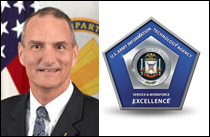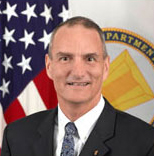
Pentagon’s new shared IT services office to launch July 20
About 63 organizations will benefit from this new service provider, Greg Garcia, the executive director of the Army IT Agency, tells Federal News Radio.
The new Joint IT Single Service Provider-Pentagon organization will meet initial operating capability in just a few weeks.
But the effort really started months or even years ago.
Greg Garcia, the executive director of the Army IT Agency, said his office has been the single agency manager for the Pentagon reservation for the common IT backbone, including transport, continuity of operations and storage, for the last two decades.

But this consolidation is taking the concept of shared services a step further.
“Really what we are going to add to that capability is, as I affectionately call it, the wall plate: the desktop, the printers, the copiers, all those user services that’s in front of those core services,” Garcia said.
He said the first phase of consolidation will affect about 63 organizations to ensure they get the value of efficient delivery and cost savings from consolidation.
Deputy Defense Secretary Bob Work signed a memo May 1 establishing the Joint IT Single Service Provider-Pentagon. Through the policy, DoD is consolidating the Army IT Agency, the Office of the Secretary of Defense’s Enterprise Information Technology Service Division (EITSD) and possibly several smaller IT service providers in the new organization.
“Just within the two organizations there are hundreds of contracts, that’s hundreds of man-hours that take to do that. We are looking to streamline that. One for instance, we looked at fourth quarter 2015 contracts and we were able to consolidate 13 contracts right away. We’re looking at other ways to begin that implementation,” Garcia said. “We are looking for initial operating capability by the 20th of July and that really is going to forge a strong relationship between those two organizations coupled with the strength of the enterprise provider of DISA to really bring that full capability to the Pentagon tenants for the end-to-end IT services. It’s pretty exciting.”
The consolidation effort is part of a bigger change the Army IT Agency is helping to usher in across the military offices in the Pentagon.
Garcia said new technologies are disrupting the tried-and-true legacy configuration of networks.
“Certainly, software-defined networks offer a brand new way to think about high reliability, highly resilient and highly capable systems that really are not limited,” he said. “You have scenario planning built in because it’s rapidly configurable and rapidly changeable where hardware solutions are a little less of that. I think also virtualization is a huge activity. The technology today lets you virtualize every transaction you work on and put that in its own security bubble. Certainly, application virtualization and server virtualization are important stuff. The cyber area also is critical in keeping up with the innovation cycle.”
The Army IT Agency completed the fielding and production of a virtual desktop interface (VDI) for the Joint Staff. Garcia said they will expand their VDI effort by another 8,000 to 12,000 for the headquarters Department of Army on the unclassified side.
He said other Pentagon-based offices also are asking about the possibility of moving to VDI.
“The next iteration of that innovation is how do we perhaps get down to fewer [desktop] images to manage,” Garcia said. “One thing the team has looked at is what we called affectionately JADE, the Joint Active Directory Environment, where we are looking to be able to do multi-tenants, and then reduced tenants to have a common image, again further pushing the commonality, the shared services ability of our organization to deliver those great products and services to our customers.”
He said JADE will help the new shared service provider manage the infrastructure to ensure their customers are getting the best performance and reduce complexity of the desktop.
“I think it’s a great foundation for identity management, both of individuals and objects,” Garcia said. “With an Active Directory structure that is shared, you can begin to build rule sets, authentication procedures all in the background that allows the confidentiality, the integrity and the availability of those underlying systems be it email, unified communications or access to applications underneath that in a proactive manner.”
All of these efforts are coming because of the support the Army IT Agency is getting from Defense Department leaders to be more innovative.
“The Army operating concept is to win in a complex world. That really is the challenge we face today, operationally and in cyber,” Garcia said. “Those are very complex, and innovation is the key to bring those capabilities to bear at a price point that we can afford and accomplishes that mission.”
Copyright © 2025 Federal News Network. All rights reserved. This website is not intended for users located within the European Economic Area.
Jason Miller is executive editor of Federal News Network and directs news coverage on the people, policy and programs of the federal government.
Follow @jmillerWFED




